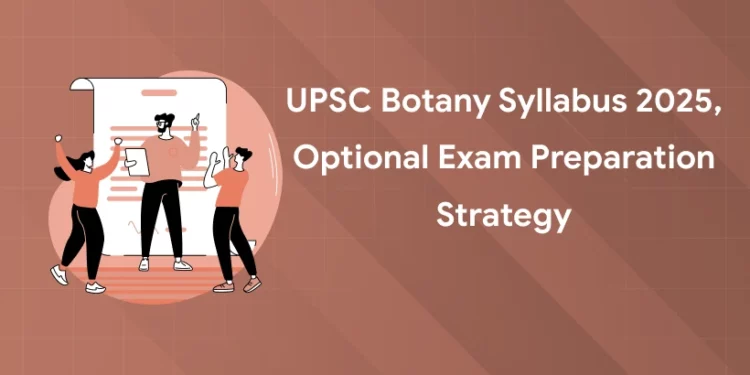Table of Contents
The UPSC Civil Services Examination is the most competitive examination in India, and the right optional subject plays a vital role in your success. For science enthusiasts, Botany is quite the best option. It is logical, structured, and has a high scoring potential. If you’re considering Botany as your optional subject in 2024, this blog will guide you through the syllabus and provide a strategic approach to preparation.
UPSC Botany Syllabus 2024 Highlights
UPSC Botany Optional Syllabus has been divided into two papers, which carry 250 marks each. This will add up to the total of 500 marks. The UPSC Botany Optional Syllabus comprises 11 major topics, which have several subtopics. In order to cover up the botany syllabus for UPSC, candidates must develop a coherent strategy to cover every topic.
This would increase their prospects of getting a good score and clearing the second phase of the UPSC Exam. Candidates can have a look at the table of the UPSC Botany Syllabus 2024.
| Parameter | Details |
|---|---|
| Name of Conducting Body | UPSC |
| Mode of Exam | Paper Pen based examination (offline mode) |
| Botany Optional Subject | Paper I & II |
| Total Questions | 5 (for both Paper I & II) |
| Total Marks | 250 Marks for Each (Paper I & II) |
| Total Time | 3 Hours Each |
| Language of Question Paper | English and Hindi only |
| Official Website | upsc.gov.in |
Crack UPSC with Expert Mentors! Get Free Demo Classes!
UPSC Botany Syllabus 2024 – Mains
1: Which one of the following is not a Harappan site?
Before sitting for the exam, candidates must study the UPSC Botany Syllabus 2024. From here, the candidate will be able to identify the prominent topics and weightage for each of them. The topics covered in the UPSC Botany Optional syllabus for the mains are as follows:
PAPER – I
- Microbiology and Plant Pathology:
Structure and reproduction/multiplication of viruses, viroids, bacteria, fungi and mycoplasma; Applications of microbiology in agriculture, industry, medicine and in control of soil and water pollution; Prion and Prion hypothesis. Important crop diseases caused by viruses, bacteria, mycoplasma, fungi and nematodes; Modes of infection and dissemination; Molecular basis of infection and disease resistance/defence; Physiology of parasitism and control measures. Fungal toxins. Modelling and disease forecasting; Plant quarantine.
- Cryptogams:
Algae, fungi, lichens, bryophytes, pteridophytes-structure and reproduction from evolutionary viewpoint; Distribution of Cryptogams in India and their ecological and economic importance.
- Phanerogams:
Gymnosperms: Concept of Progymnosperms. Classification and distribution of gymnosperms. Salient features of Cycadales, Ginkgoales, Coniferales and Gnetales, their structure and reproduction. General account of Cycadofilicales, Bennettitales and Cordiaitailes; Geological time scale; Type of fossils and their study techniques. Angiosperms: Systematics, anatomy, embryology, palynology and phylogeny. Taxonomic hierarchy; International Code of Botanical Nomenclature; Numerical taxonomy and chemotaxonomy; Evidence from anatomy, embryology and palynology. Origin and evolution of angiosperms; Comparative account of various systems of classification of angiosperms; Study of angiospermic families— Mangnoliaceae, Ranunculaceae, Brassicaceae, Rosaceae, Fabaceae, Euphorbiaceae, Malvaceae, Dipterocarpaceae, Apiaceae, Asclepiadaceae, Verbenaceae, Solanaceae, Rubiaceae, Cucurbitaceae, Asteraceae, Poaceae, Arecaceae, Liliaceae, Musaceae and Orchidaceae. Stomata and their types; Glandular and non-glandular trichomes; Unusual secondary growth; Anatomy of C3 and C4 plants; Xylem and phloem differentiation; Wood anatomy. Development of male and female gametophytes, pollination, fertilization; Endosperm—its development and function. Patterns of embryo development; Polyembroyony, apomixes; Applications of palynology; Experimental embryology including pollen storage and test-tube fertilization.
- Plant Resource Development:
Domestication and introduction of plants; Origin of cultivated plants, Vavilov’s centres of origin. Plants as sources for food, fodder, fibres, spices, beverages, edible oils, drugs, narcotics, insecticides, timber, gums, resins and dyes; latex, cellulose, starch and its products; Perfumery; Importance of Ethnobotany in Indian context; Energy plantations; Botanical Gardens and Herbaria.
- Morphogenesis:
Totipotency, polarity, symmetry and differentiation; Cell, tissue, organ and protoplast culture. Somatic hybrids and Cybrids; Micropropagation; Somaclonal variation and its applications; Pollen haploids, embryo rescue methods and their applications.
Crack UPSC with Expert Mentors! Get Free Demo Classes!
PAPER-II
- Cell Biology:
Techniques of cell biology. Prokaryotic and eukaryotic cells—structural and ultrastructural details; Structure and function of extracellular matrix (cell wall) and membranes-cell adhesion, membrane transport and vesicular transport; Structure and function of cell organelles (chloroplasts, mitochondria, ER, dictyosomes ribosomes, endosomes, lysosomes, peroxisomes; Cytoskelaton and microtubules; Nucleus, nucleolus, nuclear pore complex; Chromatin and nucleosome; Cell signalling and cell receptors; Signal transduction Mitosis and meiosis; molecular basis of cell cycle. Numerical and structural variations in chromosomes and their significance; Chromatin organization and packaging of genome; Polytene chromosomes; B-chromosomes—structure, behaviour and significance.
- Genetics, Molecular Biology and Evolution:
Development of genetics, and gene versus allele concepts (Pseudoalleles); Quantitative genetics and multiple factors; Incomplete dominance, polygenic inheritance, multiple alleles; Linkage and crossing over of gene mapping including molecular maps (idea of mapping, function); Sex chromosomes and sex-linked inheritance; sex determination and molecular basis of sex differentiation; Mutations (biochemical and molecular basis); Cytoplasmic inheritance and cytoplasmic genes (including genetics of male sterility). Structure and synthesis of nucleic acids and proteins; Genetic code and regulation of gene expression; Gene silencing; Multigene families; Organic evolution-evidences, mechanism and theories. Role of RNA in origin and evolution.
- Plant Breeding, Biotechnology and Biostatistics:
Methods of plant breeding—introduction, selection and hybridization (pedigree, backcross, mass selection, bulk method); Mutation, polyploidy, male sterility and Heterosis breeding. Use of apomixes in plant breeding; DNA sequencing; Genetic engineering—methods of transfer of genes; Transgenic crops and biosafety aspects; Development and use of molecular markers in plant breeding; Tools and techniques—probe, southern blotting, DNA fingerprinting, PCR and FISH. Standard deviation and coefficient of variation (CV). Tests of significance (Z-test, t-test and chi-square tests). Probability and distributions (normal, binomial and Poisson). Correlation and regression.
- Physiology and Biochemistry:
Water relations, mineral nutrition and ion transport, mineral deficiencies. Photosynthesis—photochemical reactions, photophosphorylation and carbon fixation pathways; C3, C4 and CAM pathways; Mechanism of phloem transport, Respiration (anaerobic and aerobic, including fermentation)—electron transport chain and oxidative phosphorylation; Photorespiration; Chemiosmotic theory and ATP synthesis; Lipid metabolism; Nitrogen fixation and nitrogen metabolism. Enzymes, coenzymes; Energy transfer and energy conservation. Importance of secondary metabolites. Pigments as photoreceptors (plastidial pigments and phytochrome). Plant movements; Photoperiodism and flowering, vernalization, senescence; Growth substances—their chemical nature, role and applications in agri-horticulture; growth indices, growth movements. Stress physiology (heat, water, salinity, metal); Fruit and seed physiology. Dormancy, storage and germination of seed. Fruit ripening—its molecular basis and manipulation.
- Ecology and Plant Geography:
Concept of ecosystem; Ecological factors. Concepts and dynamics of community; Plant succession. Concepts of biosphere; Ecosystems; Conservation; Pollution and its control (including phytoreme-diation); Plant indicators; Environment (Protection) Act. Forest types of India— ‘Ecological and economic importance of forests, afforestation, deforestation and social forestry; Endangered plants, endemism IUCN categories, Red Data Books; Biodiversity and its conservation; Protected Area Network; Convention of Biological Diversity, Farmers’ Rights; and Intellectual Property Rights; Concept of Sustainable Development; Biogeochemical cycles. Global warming and climatic change; Invasive species; Environmental Impact Assessment; Phytogeographical regions of India.
Botony Syllabus for UPSC PDF
Strategy for UPSC Botany Exam Preparation
A strategic and disciplined approach is necessary for success in Botany. Here’s how to prepare effectively:
Initial Preparatory Steps
- Understand the Syllabus: Familiarize yourself with the entire syllabus. Break it down into manageable sections and prioritize topics based on their weight and difficulty.
- Collect the Right Resources: Refer to standard textbooks and class notes. Some essential books include:
- “Botany for Degree Students” by A.C. Dutta
- “Textbook of Botany” by C.P. Khare
- “Plant Physiology” by Salisbury and Ross
- “Ecology” by P.D. Sharma
- “Plant Breeding” by B.D. Singh
Importance of Botany in UPSC Preparation
Botany can be a rewarding optional subject for several reasons:
Overlap with General Studies
Botany has significant overlap with General Studies, especially in areas like:
- Environment and Ecology: Topics such as climate change, biodiversity, and conservation are important in both Botany and General Studies.
- Science and Technology: Biotechnology advancements and agricultural practices are discussed in the General Studies syllabus, and your Botany preparation will keep you well-versed in these topics.
Scoring Potential
Botany is considered a high-scoring subject due to its clear concepts and logical structure. With consistent effort, mastering the subject becomes easier than many other optional subjects.
Advantages for Science Background Students
For the science background aspirants, Botany presents a logical and structured approach to studying. It is very much dependent on the core principles which make it relatively easier for those who are already familiar with biological sciences.
Crack UPSC with Expert Mentors! Get Free Demo Classes!











